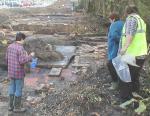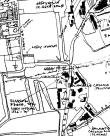
Time Team - Excavating alongside the Wheelhouse. [Full image 45.5kb]
Over the last month or so three events have taken place. Firstly, we had the visit of the Time Team, then last week a meeting of Wandle Heritage to receive a report of the consultants on the possibility of a new Heritage Centre for Merton Priory, and the commencement of a new excavation to ‘get to the bottom' of Bennett's mill.
 |
Time Team - Excavating alongside the Wheelhouse. [Full image 45.5kb] |
Rumours had been circulating for some time that they were to come, and exploratory phone calls were received at the Museum. Their remit was clear, it was the Industrial nature of the site that interested them, and looking particularly at the time span was 1890 to 1940.
You will have to await the program's broadcast in the Spring to see how they fared, but the Museum was happy to be able to supply information and expertise to help them on their way.
The highlight for us was the active participation of Mary Hart in the setting up of the block printing demonstration, and, even more critically, kidnapping Bill Rudd (who had come to the site as an innocent spectator) and persuading him to reprise his role as tierer some 60 years after he last worked at Liberty's.
Mary took the opportunity of meeting and comparing notes with the Liberty Archivist, who was there for the first day, and founding a working relationship with Valerie Bryant the printer from Quarry Bank Mill who had been brought in by Time Team as the printer for the demonstration.
Much useful information has come out of the mix, and thanks to Mike Forsyth and Val Lofts for the loan of their blocks and materials to help set the scene.
Dominic Tweedle of Continuum Group presented their stage 2 Report to a special meeting of Wandle Heritage at the Wheelhouse on 11th November.
A considerable amount of research and analysis had clearly gone into their work to date, and their initial conclusions could be briefly summarised as follows:
In general, the feedback from the meeting was regarded as being good, and Mr Tweedle welcomed the additional suggestions for passive displays by engaging the developer in ensuring his architects build heritage into the new buildings, both by using appropriate building names, and by suitable decoration. We await to see what transpires next.
 |
[Full image 67kb] |
 |
[Full image 72.5kb] |
The good news is that Museum of London Archaeological service, as represented by Dave Saxby, has been funded to do a detailed excavation of Bennetts Mill. The bad news is that this excavation and recording of the site will release the full development on the William Morris carpark area, starting in January, which will destroy most of what has then been found.
Bennett's mill is well known by name, and Bennetts Ditch is still a feature of the MAM site, forming the southern boundary. Not much is actually know about its history, and Dave's work will help to fill those gaps. Interestingly, the mill as we know it dates from 1802, and its proximity to the Surrey Iron Railway (which was then under construction) may not have been a coincidence.
We look forward to a report from Dave as to the extent, value and context of his finds, and another open day is to be held, probably on 30 November. In the meantime Mary Hart is helping Dave analise some colour fragments found in the excavation, which are proving to be surviving samples of indigo, as used in the dying process there
See plan for location and context. The Peter Harris drawing represents our only graphic of this Mill.
Nicholas Hart Nov 02
|
|
|
|